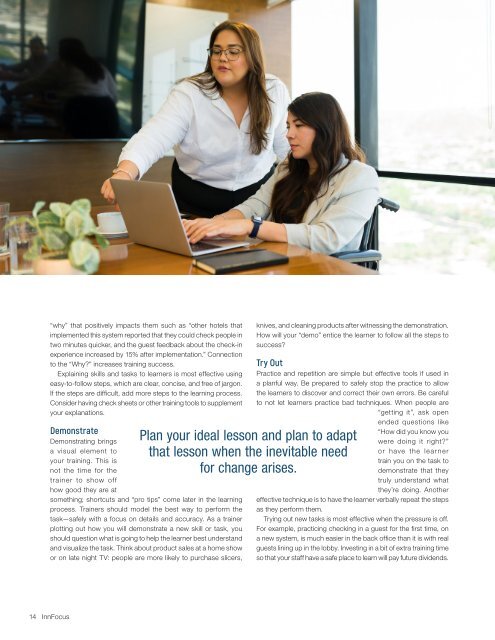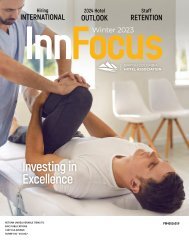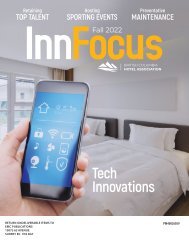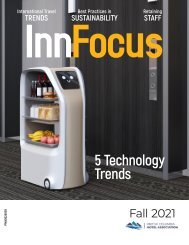InnFocus Fall 2023
InnFocus magazine for hoteliers in British Columbia
InnFocus magazine for hoteliers in British Columbia
Create successful ePaper yourself
Turn your PDF publications into a flip-book with our unique Google optimized e-Paper software.
“why” that positively impacts them such as “other hotels that<br />
implemented this system reported that they could check people in<br />
two minutes quicker, and the guest feedback about the check-in<br />
experience increased by 15% after implementation.” Connection<br />
to the “Why?” increases training success.<br />
Explaining skills and tasks to learners is most effective using<br />
easy-to-follow steps, which are clear, concise, and free of jargon.<br />
If the steps are difficult, add more steps to the learning process.<br />
Consider having check sheets or other training tools to supplement<br />
your explanations.<br />
Demonstrate<br />
Demonstrating brings<br />
a visual element to<br />
your training. This is<br />
not the time for the<br />
trainer to show off<br />
how good they are at<br />
something; shortcuts and “pro tips” come later in the learning<br />
process. Trainers should model the best way to perform the<br />
task—safely with a focus on details and accuracy. As a trainer<br />
plotting out how you will demonstrate a new skill or task, you<br />
should question what is going to help the learner best understand<br />
and visualize the task. Think about product sales at a home show<br />
or on late night TV: people are more likely to purchase slicers,<br />
knives, and cleaning products after witnessing the demonstration.<br />
How will your “demo” entice the learner to follow all the steps to<br />
success?<br />
Try Out<br />
Practice and repetition are simple but effective tools if used in<br />
a planful way. Be prepared to safely stop the practice to allow<br />
the learners to discover and correct their own errors. Be careful<br />
to not let learners practice bad techniques. When people are<br />
“getting it”, ask open<br />
ended questions like<br />
Plan your ideal lesson and plan to adapt<br />
that lesson when the inevitable need<br />
for change arises.<br />
“How did you know you<br />
were doing it right?”<br />
or have the learner<br />
train you on the task to<br />
demonstrate that they<br />
truly understand what<br />
they’re doing. Another<br />
effective technique is to have the learner verbally repeat the steps<br />
as they perform them.<br />
Trying out new tasks is most effective when the pressure is off.<br />
For example, practicing checking in a guest for the first time, on<br />
a new system, is much easier in the back office than it is with real<br />
guests lining up in the lobby. Investing in a bit of extra training time<br />
so that your staff have a safe place to learn will pay future dividends.<br />
14 <strong>InnFocus</strong>
















